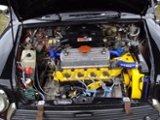Improve the Performance of Your Classic Mini Engine - a DIY Guide
Here at Mini Mania we know speed. Our specialists have decades of racing and engine building & tuning experience and would be happy to assist you in improving your Mini's speed and performance! Give us a call at 1-800-946-2642 and let's chat.
If you want to improve the performance of your MINI (2001 and later)- Change your car selection to NEW MINI.

Mini Speed and What You Can Do About ItStandard Minis have always been slower than their handling was capable of. Fortunately, many people have devoted their careers to making Minis go faster. As a result, you can fit your Mini with a double overhead cam 16 valve cylinder head and programmable electronic fuel injection. Fortunately, you need not go that far to extract surprisingly large amounts of power from your Mini. First, a brief review of the commonly available A-series motors that can be fitted to any Mini: |
| Model | Capacity | Power | Max Street Power | Comments |
| Mini 1959-83 | 848cc | 34 bhp | 50 bhp | Original Mini motor. |
| Austin 1100/Mini Clubman/100 Special 1961-1980 |
1098cc | 48 bhp | 70 bhp | Very torquey. Same bore as 848cc/998cc. |
| Mini Cooper S/Austin 1300GT 1964-1971 |
1275cc | 72+ bhp | 100+bhp | Easy performance boost without engine mods. |
| MG Metro (interchangeable into any Mini or Mini Cooper) |
1275cc | 72 bhp | 100+bhp | These engines are a great starting point for building a Killer Engine! |
| MG Metro Turbo |
1275cc | 93bhp | 100+bhp | Harder to install, "Mini Turbo" has a certain ring to it. Strong engine with turbo removed. |
There are other configurations, such as the 997cc Cooper and the 970cc and 1071cc Cooper S, that are not mentioned as these are too expensive and rare to be used to boost the performance of other Minis.
Some car engine configurations are lumped together such as the 1300GT and Cooper S, despite the engines not being exactly the same. Differences in camshaft, cylinder heads and carburation account for the differing bhp figures for motors of the same capacity.
Improving your BHP - Standard Engine Swaps
The cheapest way to add more power is to add more cc's. This is certainly true of the Mini.
Their 1275cc engines are usually cheaper than smaller motors with extensive modifications plus they are more tractable when giving the same amount of power. However, they are noisier and vibrate more than the smaller engines.
If you have a small-engine Mini, consider replacing it with a larger car engine as your first step towards more power, as a larger engine is a better base for future modifications.
Minis already equipped with 1275cc engines can also be improved by swapping for one in a higher state of tune, most commonly the MG Metro engine. This method has the advantages that the engine is all-standard and there is no need to dismantle it for its camshaft and cylinder head.
Modifying your Engine - Basics
But sometimes, it is not practical to swap an entire engine and if you already have a good 1275cc engine installed, consider this instead...
...a Stage 1 kit . Stage 1 Kits usually consists of a new exhaust, LCB exhaust manifold, intake manifold, performance air filter and replacement carburetor needle, and is available for all engine sizes. These elements are vital for future modifications and represent the cheapest methods of extracting more power from the car's engine.
And best yet, you can expect a power improvement of 20-25% PLUS an improvement in fuel economy. These kits can be fitted by anyone with basic mechanical knowledge.
Another possible modification is to replace the carburetor with a larger one. This does not provide significant advantages for engines in standard tune but should be a prerequisite for fitting a Stage 1 Kit.
And For Even More Power Consider These Mods
Some tandard DIY Mods to your Classic Mini are often easy and effective but does requires modifications to the engine and can include things such as Rocker Arms, Air Filters, and Exhausts.
You might also consider replacing the cylinder head with one that has modified chambers and ports and larger valves. The cost of a replacement head varies according to the aggressiveness of the modifications.
The next component to be changed is the camshaft. All camshafts represent a compromise between low-end and top-end power - a duration of 260 degrees is about as long as you can go without noticing a loss in low-end power. A duration of 280 degrees or more results in less power than a standard motor (or at best, the same amount), until 2000-3000 rpm for "street" cams or 4000+ rpm for race cams, where the power curve rises rapidly, suddenly providing huge amounts of power.
Longer-duration cams cause the car engine to idle unevenly and require frequent slipping of the clutch at low speeds, and also cause poor fuel economy at low rpm. An engine with one of these cams is likely to develop less power than an unmodified car below 3000 to 4000rpm. In all the car can be extremely unpleasant to drive around town. Camshaft manufacturers can recommend the appropriate cam for your intended uses.
Re-boring the engine is the other direction to go in to increase power. Given the expense, it is best to start with a 1275cc block. Standard overbores are 1293cc, 1310cc, and 1328cc, although the block is commonly bored to 1380cc while retaining reliability.
Bores larger than this can take the motor to approximately 1400cc but bore strength is compromised.
To further increase cc's the engine can be stroked - the crankshaft journals are offset-ground and smaller con-rods are used to increase the stroke. This is expensive but yields 1430-1480cc engines. 1600cc motors have been produced by this method but can only be considered experimental.
Other Things You Might Not Have Considered
Your Gearbox
The more power, the more wear on the gearbox and engine. The gearbox is mentioned first because it was originally designed for an 848cc engine delivering 34bhp and has not been significantly strengthened since.
About 90bhp with a 1380cc motor is the limit for good all-round tractability and reasonable longevity of the engine and gearbox, without serious modifications to strengthen either. Even at this level, expect to replace gearboxes more frequently, and car engine life will be shortened if the car is driven hard.
Around 100bhp is common. Around this amount of power, relatively expensive strengthened engine and gearbox parts must be used and low-end driveability is compromised. It is not cheap to set up a motor to deliver this amount of power reliably, and peak rpm will be somewhere around 6000rpm or beyond - an engine in this state of tune must be revved high to extract peak power.
Radiator and Brakes Too
Any increase in power beyond that of a standard 1275cc motor can have some compromising effects on the rest of the car. It is usually necessary to fit an uprated radiator, and the brakes may no longer be up to stopping the car if it is driven more aggressively.<
Engine Swap Details
There are some considerations when swapping a non-Mini engine (VTEC) or a Mini engine from a different year into your car:
• The motor mounts from your Mini engine should be bolted to the new car engine - the old mounts can be discarded. Also transfer the engine-end mounts for the motor steadies from the old engine to the new engine.
• You will probably need to transfer the inner driveshaft joints from your motor to the new motor. Note that pot-type inner driveshaft joints changed in size around 1977, so you cannot fit driveshaft ends from post-'77 into pot joints from pre-'77.
• Allegro/Austin 1300 engines have larger-bore intake/exhaust manifolds that do not fit Mini exhausts. Use a Mini manifold or preferably replace with LCB plus performance exhaust.
• If you put an engine with an alternator into a car with a dynamo, you will need to change the car from positive to negative earth and change the wiring, or put the dynamo on the new car engine.
• A spacer may be needed before the radiator fan so that it is close to the radiator - different sizes are available.
• The heater takeoff point on the cylinder head may not be drilled (Metro), or may be covered by a blanking plate (Allegro, Minis fitted with no heater as standard). This can be drilled if it is not already, and the studs and heater valve from the Mini fitted. The studs are always drilled and tapped.
• The differential on Austin 1300s is usually 3.65:1. The differential on Austin Allegro 1300s is usually 3.939:1. The 3.939 diff gives excellent acceleration but you find yourself in fourth gear by 50km/h with 10 inch wheels, and revving very highly. To change the diff, the motor must be split from the gearbox so the gear that drives the differential can be changed, as well as the differential, because they are matched sets. If the differential is not changed to whatever your car was using, the speedometer and odometer will need to be recalibrated.
• When swapping to a 1275cc engine, use a 1275GT bottom radiator hose. You will also need a Cooper S or 1275GT upper radiator bracket and top hose.
If You're Not Up To It - Let Us Help
If you're looking to build the ultimate road or race engine, let Mini Mania build it for you! In this video we give just one example of the higher end racing components available to create the ultimate in Classic Mini Cooper power units. If you'd like us to quote on the engine of your dreams see our contact information below..
Please feel free to contact us at 1-800-946-2642 with any questions regarding enhancing the performance of your classic mini motor. Our technical experts are more than happy to help!








